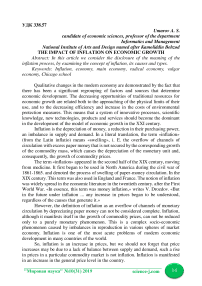The impact of inflation on economic growth
Автор: Umarov A.S.
Журнал: Мировая наука @science-j
Рубрика: Основной раздел
Статья в выпуске: 10 (31), 2019 года.
Бесплатный доступ
In this article we consider the disclosure of the meaning of the inflation process, by examining the concept of inflation, its causes and types.
Inflation, economy, main economy, radical economy, vulgar economy, chicago school
Короткий адрес: https://sciup.org/140263939
IDR: 140263939 | УДК: 338.57
Текст научной статьи The impact of inflation on economic growth
Qualitative changes in the modern economy are demonstrated by the fact that there has been a significant regrouping of factors and sources that determine economic development. The decreasing opportunities of traditional resources for economic growth are related both to the approaching of the physical limits of their use, and to the decreasing efficiency and increase in the costs of environmental protection measures. This means that a system of innovative processes, scientific knowledge, new technologies, products and services should become the dominant in the development of the model of economic growth in the XXI century.
Inflation is the depreciation of money, a reduction in their purchasing power, an imbalance in supply and demand. In a literal translation, the term «inflation» (from the Latin inflatio) means «swelling», i. E. the overflow of channels of circulation with excess paper money that is not secured by the corresponding growth of the commodity mass, which causes the depreciation of the monetary unit and, consequently, the growth of commodity prices.
The term «inflation» appeared in the second half of the XIX century, moving from medicine. It first began to be used in North America during the civil war of 1861-1865. and denoted the process of swelling of paper-money circulation. In the XIX century. This term was also used in England and France. The notion of inflation was widely spread in the economic literature in the twentieth century. after the First World War. «In essence, this term was money inflation,» writes V. Drozdov. «But in the future under inflation ... any increase in prices began to be understood, regardless of the causes that generate it.»
However, the definition of inflation as an overflow of channels of monetary circulation by depreciating paper money can not be considered complete. Inflation, although it manifests itself in the growth of commodity prices, can not be reduced only to a purely monetary phenomenon. This is a complex socio-economic phenomenon caused by imbalances in reproduction in various spheres of market economy. Inflation is one of the most acute problems of modern economic development in many countries of the world.
So, inflation is an increase in prices, but we should not forget that price increases may be due to a lack of balance between supply and demand, such a rise in prices in a particular commodity market is not inflation. Inflation is manifested in an increase in the general price level in the country.

For a more objective view of inflation, one should consider the various inflation theories that exist today.
The history of the economy includes a rather large number of different economic doctrines, schools and trends: classics and neoclassicists, mercantilists, physiocrats, Marxist economy, institutional, and mainstream economics, radical economy, vulgar economy, Chicago school and liberalism, the Elbreite trend and many others. Representatives of almost each of these areas have developed or are developing their views on the global economic problems of mankind. There are also their theories concerning inflation as one of the most serious problems hindering full-fledged economic development. Here are some of them.
In the traditional Marxist economy, inflation was understood as a violation in the process of social production in pre-capitalist formations and under conditions of capitalism, which manifested itself in overflowing the sphere of circulation with money signs in excess of the real needs of the economy and their depreciation. Inflation, according to the Marxist school, is organically linked to the features of the reproductive cycle, state-monopoly regulation of economic processes, militarization of the economy, unemployment, etc. It is generated by the socioeconomic contradictions of capitalist production, the disproportion between the real volume of the social product and its value expression. And it is used by the ruling exploiting classes to redistribute the national income and national wealth to their own advantage by reducing the real incomes of the working people. To its immediate causes, the Marxist school attributed objectively the changes in the volume and structure of social production, the policy of the monopolies and the imperialist states, the main one of which was the budget deficit.
English economist A. Phillips in 1958, using the data of UK statistics for the years 1861-1956, proposed a curve reflecting the inverse relationship between the level of wage rates and the unemployment rate. It was found that an increase in unemployment in England of more than 2.5 - 3% led to a sharp slowdown in price and wage growth. Hence the conclusion that the decrease is accompanied by an increase in prices and wages. Thus, the unemployment rate can be reduced by accelerating the rate of inflation.
The economist R. Lipsi summed up the theoretical basis for the calculations of Phillips. Later, American economists P. Samuelson and R. Solow modified the Philips curve, replacing the wage rates with the growth rates of commodity prices. In this form, the curve began to be used for economic policy, primarily to determine the levels at which a high level of employment and production and a certain stability of prices are possible.
The abscissa shows the unemployment rate, on the y-axis - the growth rate of commodity prices. If the government considers the unemployment rate u1 to be excessively high, then budgetary and monetary measures stimulating demand are conducted to reduce it, which leads to expansion of production and creation of new jobs. The unemployment rate is reduced to, but the rate of inflation to P2 is simultaneously increasing. The resulting conditions can cause crisis phenomena,

which will force the government to take measures to reduce the rate of price growth to the level of P3, and unemployment will increase to the level of u3.
In practice, it turned out that the Phillips curve is applicable to the economic situation in the short term, because in the long term, despite high unemployment, inflation continues to increase, which is explained by a whole set of circumstances.
One of such circumstances is the policy of stimulating demand. The government's desire to reduce the unemployment rate at the cost of increasing inflation is successful only if the population succeeds in creating so-called «false expectations.» For example, working for hire, watching the growth of wage rates, increase labor supply. And then, as expected in the concept of the Phillips curve, there is an increase in inflation and associated nominal wages. However, as soon as people start to notice that the real wage, unlike the nominal one, decreases all the time, the increase in the supply of labor stops.
Keynesians distinguish three main factors of inflation: expansionary financial and monetary policy, stimulating demand; increase in production costs; practice of monopolistic pricing. As J.M.Keyns himself notes, «when the further increase in effective demand no longer leads to an increase in output, but is completely exhausted in increasing the unit of costs strictly proportional to the increase in effective demand, we reach a provision that is quite appropriate to call genuine inflation.»
Keynesians view the money supply as an endogenous variable, which depends on the policy of the monetary authorities and the level of economic activity. «Inflation of costs» is interpreted as the result of several factors. The main one is considered to be an increase in wages above the level corresponding to the growth of labor productivity. Although, according to Keynes, «full or ... approximately full employment is a rare and quick-passing event.»
The level of employment is determined by Keynes by the point of intersection of the functions of aggregate demand and aggregate supply. It is at this point that the expected profit by entrepreneurs will be the greatest. In advocating the conscious management of monetary circulation, Keynes considered it necessary to use various kinds of measures only with part-time employment. He warned against using monetary leverage in conditions of full employment, believing that in this case they could cause unrestrained inflation.
Used sources:
Список литературы The impact of inflation on economic growth
- Management of the organization / Ed. AGPorshneva, Z.P. Rumyantseva, N.A. Salomatin. - Moscow: Infra - M, 1999.
- Fundamentals of commercialization of the results of NPOKR and technology / Comp. N.M. Fresheret. M.: ANH, 1999.


